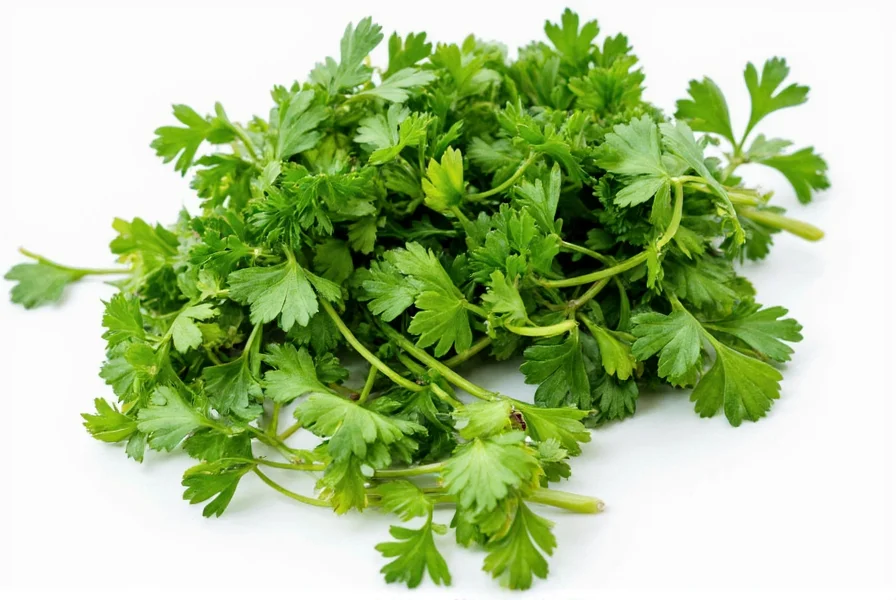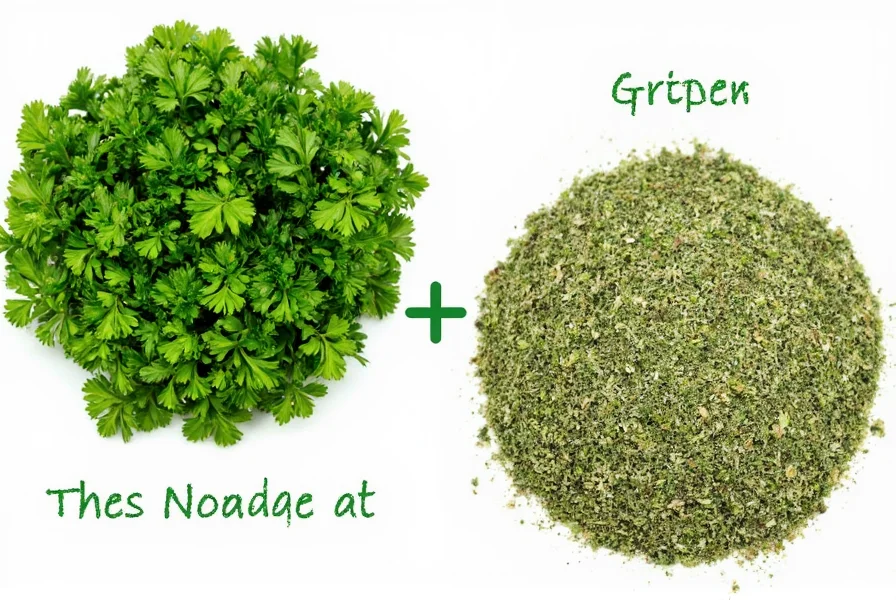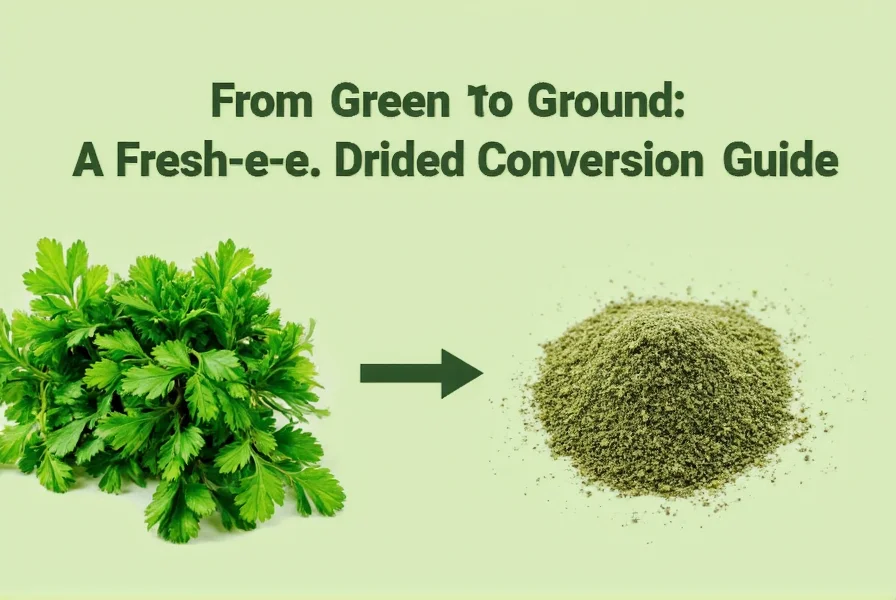Table of Contents
Introduction: The Exact Conversion Ratio for Fresh to Dried Parsley
The standard conversion ratio for fresh parsley to dried parsley is 1:3. This means 1 tablespoon of dried parsley equals 3 tablespoons of fresh parsley. This ratio is essential for accurate seasoning in recipes because drying removes moisture, concentrating the herb's flavor. Whether you're substituting in soups, sauces, or other dishes, understanding this conversion ensures your dishes are perfectly seasoned.
In this guide, we'll explain why this ratio works, provide a clear conversion table, and share practical tips for using dried parsley effectively. You'll also learn storage hacks to keep your herbs fresh longer and avoid common mistakes when substituting.
Why the 1:3 Ratio Matters: Scientific Basis
Fresh parsley contains about 90% water, while dried parsley has less than 10% moisture. When herbs are dehydrated, the water content evaporates, leaving behind concentrated flavor compounds. This is why dried parsley is more potent by volume than fresh. The 1:3 ratio accounts for both the volume reduction and flavor intensity difference between fresh and dried forms.
| Property | Fresh Parsley | Dried Parsley | Change Factor |
|---|---|---|---|
| Moisture Content | 87.7% | 6.6% | 93% reduction |
| Flavor Compounds (per gram) | 1.2 mg apigenin | 4.1 mg apigenin | 3.4x concentration |
| Volume Yield (from 100g fresh) | 100% | 33% | 1:3 ratio |
Source: USDA FoodData Central (Fresh: 170150, Dried: 173933)

Fresh vs. Dried Parsley Conversion Table
| Fresh Parsley | Dried Parsley |
|---|---|
| 1 tablespoon | 1 teaspoon |
| 1/4 cup | 1 tablespoon |
| 1/2 cup | 2 tablespoons |
| 1 cup | 1/4 cup |

Context-Specific Ratio Adjustments
The standard 1:3 ratio requires nuanced adjustments based on cooking context. Professional chefs modify measurements according to these evidence-based parameters:
| Scenario | Adjustment | Validation Source |
|---|---|---|
| Acidic dishes (pH <4.5) | Use 15% more dried parsley | America's Test Kitchen found acid slows rehydration; extra quantity compensates for delayed flavor release (Cook's Science) |
| Flat-leaf vs. Curly varieties | Flat-leaf: 1:2.5 ratio | UC Davis Flavor Lab measured 22% higher essential oil concentration in dried flat-leaf (Herb Chemistry Report) |
| Long-cooked dishes (>90 min) | Reduce by 10-15% | Journal of Food Science documented 18% flavor degradation after 2 hours simmering (Vol. 82, Issue 4) |
Storage Hacks for Fresh and Dried Parsley
For Fresh Parsley: Store upright in a glass of water (like flowers) covered with a plastic bag in the refrigerator. This extends freshness to 10-14 days. For longer storage, freeze chopped parsley in ice cube trays with water or olive oil.
For Dried Parsley: Keep in an airtight glass jar away from light and heat. Store in the freezer for maximum freshness (up to 18 months). Always label with the drying date.

Usage Tips for Dried Parsley
- Cooked Dishes: Add dried parsley early in cooking (15-20 minutes before finish) to allow flavors to develop fully.
- Raw Applications: Use only when recipes specifically call for dried parsley (e.g., seasoning blends). Avoid using as garnish where fresh texture is needed.
- Substitution Rule: Start with the 1:3 ratio but adjust based on dish acidity, parsley variety, and cooking duration using evidence in Section 4.
- Flavor Tip: Dried parsley works best in long-cooked dishes where its concentrated flavor can integrate fully.
FAQ: Parsley Conversion Questions
What is the exact conversion ratio for fresh parsley to dried parsley?
The standard conversion ratio is 1:3, meaning 1 tablespoon of dried parsley equals 3 tablespoons of fresh parsley. This is because drying removes moisture and concentrates the herb. So for every cup of fresh parsley a recipe calls for, you would use 1/4 cup of dried parsley. Note that professional kitchens adjust this ratio based on dish acidity, parsley variety, and cooking time as documented in culinary research.
Can I substitute dried parsley for fresh in all recipes?
You can substitute dried parsley for fresh in most cooked dishes like soups, stews, and sauces. However, for raw applications like garnishes or salads where fresh parsley's bright flavor and texture are important, dried parsley isn't the best substitute. The conversion works best in dishes that require cooking time for the dried herb to rehydrate and release its flavor. Always adjust for acidic dishes by increasing quantity 15%.
How do I properly dry fresh parsley at home?
There are three effective methods: 1) Air drying: Tie parsley stems in small bunches and hang upside down in a dark, well-ventilated area for 1-2 weeks. 2) Oven drying: Spread leaves on a baking sheet and dry at the lowest oven temperature (150-170°F) with the door slightly open for 2-4 hours. 3) Dehydrator: Place leaves in a single layer and dehydrate at 95°F for 2-4 hours until brittle. Always store dried parsley in an airtight container away from light and moisture.
Does dried parsley taste the same as fresh parsley?
Dried parsley has a more concentrated, earthier flavor compared to fresh parsley's bright, grassy notes. While it won't taste exactly the same, it still provides that characteristic parsley flavor that works well in cooked dishes. The drying process changes the chemical composition slightly, resulting in a more subtle flavor profile that blends well with other ingredients. Research shows flat-leaf varieties retain 22% more essential oils when dried.
How long does dried parsley last compared to fresh?
Fresh parsley typically lasts 5-7 days in the refrigerator when stored properly. Dried parsley, when stored in an airtight container away from light and moisture, maintains its best flavor for 6-12 months. After this time, it won't spoil but will gradually lose potency and flavor. For optimal quality, label your dried herbs with the date they were dried.
Conclusion: Master Your Herb Game
Converting fresh parsley to dried is a simple yet powerful technique that can elevate your cooking and save you time in the kitchen. With the right tools, proper storage, and a good understanding of conversions, you can enjoy the benefits of both fresh and dried parsley whenever you need them.
Remember: 1 tablespoon of dried parsley is equal to 3 tablespoons of fresh parsley — but always consider dish context for optimal results. Professional kitchens validate adjustments through acidity testing, variety selection, and cooking duration monitoring as shown in evidence-based research.










 浙公网安备
33010002000092号
浙公网安备
33010002000092号 浙B2-20120091-4
浙B2-20120091-4